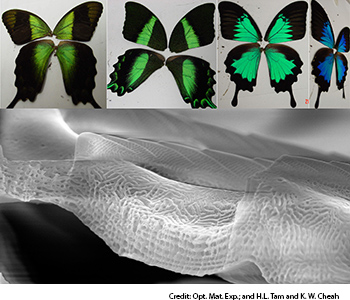
(Top) P. peranthus, P. blumei, and P. ulysses, and side view of P. ulysses. (Bottom) SEM images reveal the seven-layer cuticle structure of a Papilio blumei butterfly wing at almost 30,000× magnification.
Physicists in Hong Kong have uncovered the structure in butterfly wings that lends itself to iridescence and could lead to new designer coatings and materials. Kok Wai Cheah at Hong Kong Baptist University and colleagues found that three closely related types of tropical butterflies have subtle differences in the tiny crystals in their wings that create stunning variations of color (Opt. Mat. Exp. 3, 1087).
Using a scanning electron microscope, the researchers examined cross-sections of the wings of three related species: Papilio ulysses, Papilio peranthus and Papilio blumei, which appear bluish green, yellowish green and deep green from above, respectively. All three appear deep blue when viewed at an angle. The team discovered that the wings contain specialized nanostructures of solid flat layers known as cuticles alternating with thin “air” layers known as laminae. The laminae contain pillars of the cuticle material, which gives the wings a repeating crystal-like structure, similar to that of a Bragg reflector.
The researchers used angle-resolved reflection spectroscopy to find that differences in the reflection spectrum of the wings arise from slight differences in crystal parameters. Whereas P. ulysses has seven cuticle layers, P. peranthus has eight. Also, the thicknesses of the cuticles and air layers are slightly varied, all of which accounts for the different colors of the butterflies’ wings.
The discovery could someday lead to coatings that could be tuned to produce a desired color. The team’s next step is to investigate color-changing mechanisms in other insect body structures, such as iridescent beetle shells.
